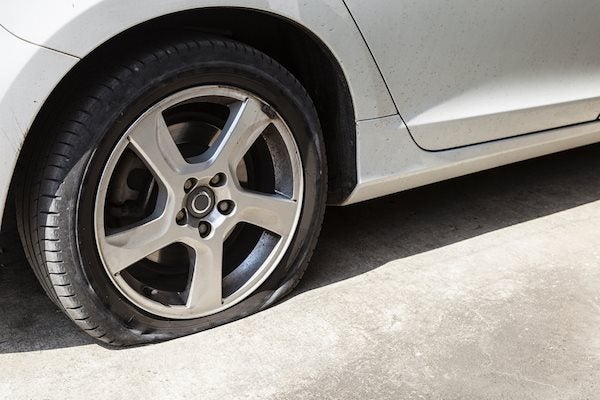How to fix a flat tire on your car
Normally, one would fix a flat by removing the punctured tire and replacing it with a spare so you can drive to a shop and get a proper replacement.
Provided you’ve got the right tools, a patch kit, and can safely remove a tire — and the tire isn’t severely damaged, of course — this is a viable short-term solution. Note that this is a short-term remedy, as patched tires are generally only safe to drive on for about 100 miles, or three days, whichever comes first. Much like using a spare tire, this isn’t going to solve the issue either. The best solution is to take your car to a professional shop to get it replaced.
Step 1: Remove the wheel with the flat tire
First, you’ll need to pop off that flat tire. Use a lug wrench to loosen the lug nuts, but don’t remove them from the bolts quite yet. Next, after loosening the nuts, affix the car jack to the proper jacking point for the vehicle you’re working on. Make sure to do this on level ground, with the car in gear, and the parking brake engaged to prevent your car from rolling, as jacking the car on an incline can be extremely dangerous. When the car is jacked up, you can remove the lug nuts and take off the tire.
Step 2: Find the leak
Once you’ve removed the tire, it’s time to find the leak. If you can visibly identify the object that’s punctured the tire whether it be a nail or something else entirely carefully pull it out. A pair of pliers comes in handy here. If you don’t know where the leak is coming from, you’ll need to find it. You can do this by inflating the tire and feeling or listening around the surface of the tire for an opening or escaping air.
Another strategy is to inflate the tire and spray it with soapy water. The escaping air will cause bubbles to rapidly form at the point of the puncture.
Step 3: Plug the hole
Once you’ve found the hole, ream it out to make sure the plug will fit. Usually, a tool for doing so is provided with your patch kit. Next, it’s time to plug the hole. Apply any necessary adhesives from the kit onto the plug, then insert it into the hole until roughly two inches of material is sticking out from the tire. Afterward, let the adhesive dry and cut off the protruding excess of the plug before discarding it.
Step 4: Test the plug
Now, it’s time to test the plug’s seal. Inflate the tire and check for escaping air using either the feeling or listening method mentioned above. Again, you can also use soap and water if you’re in need of an alternative method.
Step 5: Refit the wheel
Reattach the tire and lug nuts, but only tighten them enough so the tire will stay on. Do not tighten them all the way just yet. Lower the car to the ground and remove the jack. Once the car is safely stable on all four wheels, finalize the process by tightening the lug nuts in a star pattern, or an “X” pattern if you’re dealing with a four-bolt model. Make sure to follow the torque requirements in your car’s manual. This is when a torque wrench can come in handy.
Now, if done correctly, you should be able to get your car to a shop to have your tire replaced. Again, this is not a long-term solution, and you will need to replace your tire within either 100 miles or three days whichever comes first.

Do you have any news or article you would like us to publish? Kindly reach us via outreach@t4d.co.ke or howtodoafrica@gmail.com.




















